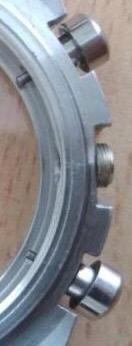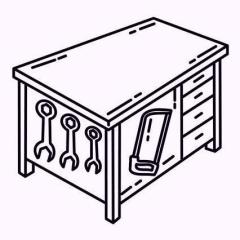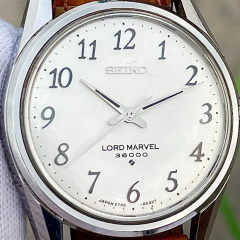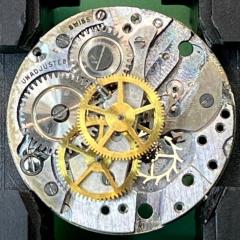Leaderboard
Popular Content
Showing content with the highest reputation on 02/18/24 in Posts
-
Of course, I can not talk about "long time experience" (I've just started), but from what I've observed is that if you don't keep the file flat on the runners-bed, the pivot has room to "escape; it rolls itself "out of bed" ( ) This hasn't anything to do with how hard you press down, the pivot has no mass, friction or power enough to push the file upwards. Because my tool is belt-driven, next to having my both hands free, I can fully concentrate on the file and the pivot, which coincidentally are the two most important parts in this exercise. If needed, I can support the hand holding the file with the other hand, or, with the other hand hold (additionally) the tip of the file for better control of the files angle. Also, IMHO, one doesn't need huge strokes with the file. In reality and under the microscope, a 1 cm stroke is already huge compared to the size of the pivot. Also, having belt-driven, I can position the microscope right above the Jacot tool and have a good view of "what's happening". I've experienced too that the pivot nearly rolled "out of bed" (due to the "incorrect" position of the file), but since I had only one thing to concentrate & to focus on, I could stop immediately to prevent worse. I guess my brain doesn't like multi-tasking, hence having the Jacot tool belt-driven is for me the solution. Of course, if the bow driving works for other people, perfect ! Two personal remarks I like to make, or better; "food for thought"; 1) It seems to me that when trying the bow, the hand holding the file mimics the movement of the hand holding the bow, but obviously in the opposite direction. My file strokes were way too long, causing the file to "wobble", tilting off the beds horizontal plane and thereby giving the pivot room to "escape". Nickelsilver's video showed how he controls the stoke-length and the position of the file, a method initially unknown to me. Since I now can fully concentrate on the file and the pivot (the rest is taken care of), that problem is solved. 2) When I was into old Land Rovers, I took an off-roading coarse in the Belgium Ardennes, conducted by a man who participated multiple times in the Paris-Dakar rally. He made a remark which always stayed with me: "When you go too fast, unwanted things start you to overcome".4 points
-
When the day disc is in place, it kicks it up anyway. So, the actual issue was that the Unlocking yoke maintaining plate was not installed right and was not holding down the date indicator driving wheel. Its back together and working, but now my winding stem no work right, so ill be "practicing" some more2 points
-
If this has been discussed elsewhere feel free to delete. So for things like the train bridge shock settings in 7XXX series seiko movements it's impossible to set them wet and have a good oil bubble. You gotta set them dry and oil from the other side. When i started out i was told you basically have to have an auto oiler for this. I got one, i hate it, it works, sometimes, but it does a terrible job at metering the oil flow and there's about a 20% chance it will overfill it instantly causing me to have to reclean the jewel and try again. On top of that, for things like the 3rd wheel in the 7s26 it according to most SHOULD be oiled with hp1300 even though the tech sheets for the various versions of the 7s26 are all over the place on this. Some iirc recommend 9010 in the shock setting and 1300 in the lower jewel. One says 9010 on both. One wants you to use grease on the bottom jewel, it's strange.. So unless you want to get two auto oilers for the two shock settings and fill one with hp1300, what do you do? Well just save yourself 100 bucks on a pretty crappy tool imo there's a much simpler way to do it. Just take your dip oiler, put a bead of oil on the back of the setting once the shock setting has been set already, then take your wheel and poke the pivot through the jewel hole and capillary action will draw in the oil and do it slowly and precise enough you get that perfect bubble every time. I don't know if this insanely easy technique is used a lot here but nobody suggested it to me when i was starting out and i blew about 120 bucks on a tool i now realize i just don't need. Just a little psa for people that aren't aware of this insanely simple technique that requires no tools.1 point
-
Same here, and I do that whenever possible. The problem is when it's not, like on pressed-in Accutron train jewels, or a handful of settings I've come across that are not meant to be disassembled.1 point
-
I came across this video recently. I think it's one of the best filmed videos explaining and demonstrating how it's done.1 point
-
I know this thread is 3 years old, but the conventional wisdom in using a loupe is with both eyes open. So if you are far sighted you should be using readers with a clip on loupe on your dominant eye. That way you can refocus on items on your bench without having to lift your loupe and putting on the readers. If you use high power readers (above 2x) then you are looking at everything close up and would have to take the high power ones off and put regular readers on to see at a close distance. I keep my readers (the ones without the loupe) on looking through the microscope and that way when I come out of the scope I can refocus immediately on grabbing a screwdriver or tweezers of the correct shape, etc. Then back to the scope. Much more efficient and less eye strain.1 point
-
complicated than that typically you lubricate the exit pallet and you have to do it three times over the revolution of the escape wheel and occasionally you might have to put a little bit of oil/grease on the entry stone if the oil didn't transfer all the way around. As far as ever seeing this technical document that is never going to happen. The watch companies make a silly assumption that people working on watches are all experts. Then as far as techniques go those are usually in separate documents like the Omega working instruction number 40 that's a lubrication document. Omega has another document for epilam. then from Megan Epilam the earliest document I have on cleaning of lubrication in 1957 basically the Epilam whole watch except pallet fork and maybe one other thing. But you'll never see the word Epilam mentioned in any of the service guides. It's only a relatively recent times that some of the technical documentation will mention Epilam. remember he wasn't pleasing one of those newfangled timing machines for amplitude. Traditionally those oils would've been organic and typically again he wasn't servicing a watch like a Rolex for five years.1 point
-
Wow, pipes, pens, watches, clocks and knives, there is all kinds of stuff here, I wanted to get a pen mandrel and acrylic/wood and make some pens but haven't done it yet, I saw one made with corn cob that was awesome looking....I have sold a few Conklins, Parkers, Watermans and others from the past...1 point
-
Hello, I am relatively new to watch repair having started at the end of 2022. Over the last year I have worked on a number of movement, largely through disassembly, cleaning, and assembly with the hope of returning a movement to working order or to get one ticking. I have made several investments that were life changers such as a microscope (Amscope with camera) and an L&R watch cleaning machine and have worked to make my investments in quality tools vs. just the junk knockoffs. I am generally working on less expensive but still quite nice movements. Most of what I work on I source from ebay and then what works well and looks presentable after my work I try to re-sell to an owner who I hope will make use of the watch that may have been neglected previously. My goal is to make my hobby self sustaining as much as I can, Ideally the amount I invest I can recovery, but I am not aiming for massive profits. My ultimate goal is to learn as much as possible so that I can become proficient enough to resuscitate a movement with issues such as broken pivot, new jewels, bent hairsprings etc. I am also very interested in watch case restoration. As a trained inorganic chemist, electroplating is something I would love to take on. It is an art, but it is also an informed art where some knowledge of chemistry is likely to be very useful. That will come in time, now its all movement focused.1 point
-
I am 50+ year clock and watch guy. I run a clock and watch business in Kingston On Canada. I am mostly self taught but have taken courses at the NAWCC in Penn, as well as take advantage of other seminars in repair work. My last course was at NAWCC from Drew Zimmerman, made a comment about BOTCHMAKERS. I consider myself as an advanced botchmaker. Good watch repair people are hard to find in my location so I look forward to this connection.1 point
-
Dot over 90" convinces me its a fake. not dot and the case to me doesn't look right the finish is all wrong.1 point
-
I have read that a way to tell an original is the "dot over 90" on the bezel. The original has it and @Nucejoe 's one doesn't.1 point
-
1 point
-
the problem is there's lots of variables here and it looks like he's handled the speed control nicely and I don't know about your setup whether you had the same control of speed situation etc. but it does seem interesting of that newfangled technology should not be used with old technology because it goes against the beliefs. If you want to see some fun find traditional watchmakers and start talking about CNC and they get really cranky fast they do not embrace modern technology and I have to wonder if that's what's happening here the inability to accept there might be a better way perhaps. Remember when this tool was invented that probably didn't even have electricity. So if they did have electricity would they have done it differently or would they make us use the bow because they like torturing us? Then how easy is it really to learn how to use this tool? Whether using a belt or the bow or something else is this really an easy tool to use?1 point
-
it appears to be that the speed is controllable and are you suggesting that he doesn't have enough concentration? just think he would have both hands free versus one hand tied up with the bow I wonder if that would make any difference at all? Then I imagine the belt when you stop stops really fast it doesn't just continue to run totally out of control. I believe he said he had a on-off switch switch should be really fast turning on and off probably much faster than somebody trying to run both hands at the same time.1 point
-
1 point
-
This is a 2836 that I have just pulled from my projects box and as with the example above from @GuyMontag there is a moment during the date change when the teeth line up perfectly with apertures in the retaining plate, however, the point at which the jumper spring starts to flick the wheel into place is just before the point of alignment (for want of a better description) and so the wheel powers through the alignment without dislodging. I had to hold the date wheel in this position to take the photograph. What is interesting here is that we seem to have a variety of different shapes of retaining plate, and the one shown by @Jon doesn't have the cut outs that align with the teeth at all, so with his example it is impossible for the wheel to jump out. It may be that something is lifting the date wheel on @JeremyLaurenson's watch such that the teeth are being pushed up against the underside of the retaining plate just enough that as the teeth align with the cut outs they are pushed through. I'm guessing that the date wheel is for a 6 o'clock date window rather than a 3 o'clock window, hence the orientation of the numbers and the misalignment at the stem (the alignment of the 13 is correct for a 6 o'clock window). Is this the original date wheel for this movement? Are the date wheel teeth all in good condition and are any of them bent either up or down compared to the others. Is the retaining plate original to this movement and this date wheel? Is it possible that the date jumper spring has a slight twist in it such that it imparts just enough upwards force to the date wheel as it turns that it causes the problem? If it is twisted away from normal such that the bottom edge of the jumper is closer to the date wheel than the top edge it will impart an upwards movement as the wheel turns.1 point
-
I've broken two pivots when I got out of sync - I wasn't holding the pivot down hard enough in the slot and the balance jumped out. I'm not sure how I'd manage with a motor driven tool1 point
-
1 point
-
1 point
-
Why motor driven. Can't you manage using a bow and find it difficult or is it to speed up your work which I do not recommend as you do not have control as you would with a bow.1 point
-
This one kind of qualifies for the 404. A seller I have done business with had this 1996 Kinectic and I was looking at it and couldn't get it to work. He said take it and open it and fi d out what's wrong and we will talk next month at the next meet. So I take it home and figure out it needs a new rechargeable kinetic battery. $24.50 later it is running beautifully. So it is free for the moment...the first Sunday of next month it might cost me $90 minus the $25 for the repair, but I am enjoying it now. Might have been a very wise move for him to let me fix it and fall for it because it likely won't come out of my collection now.1 point
-
I had teething problems with my auto oiler too. But I assumed it was because mine was a China copy. But after I sharpened the tip to a fine point and learning not to use the button on the side to dispense the oil, instead just pressing the pin down and relying on capillary action to "leak" oil into the jewel, it was quite consistent. The auto oiler makes oiling Seiko Diafix jewels less of a pain. Just clean the holes, the cap jewels and reinstall them back on the plates, then use the auto oiler to drip oil into the setting. I know some of you will say that it can be done this way with a conventional oiler too, but an auto oiler just makes it easier.1 point
-
Also worth noting rodico often isn't clean, and isn't always the best way to mop up oil. I mostly clean over the jewel with the rodico but for the rest of the underside of that area i use a tapered q tip with isopropyle alcohol and get it spotless. Just don't do that directly over the jewel hole as i imagine some ipa will get sucked in to the setting.1 point
-
Hi. One tip I heard of was to place a small round magnet beneath th e watch under the rotor thi is supposed to keep the rotor up right whilst the bridge is fitted. Never tried it but it sounds plausible. The magnetism won’t affect the watch as the rotor is already magnetised.1 point
-
I don’t disagree with analysis and don’t recommend them either but I have them and I will use them because I have trouble pulling the right amount from the oil cup for settings that are exceptionally large or small. Also, with a regular oiler I seem to have issue with jagged bubbles when epilame is involved. …the flow of oil per pump can be finely regulated. The instructions what come with are standard Bergeon confusing. The auto also have a problem with capillary flow of oil from the tank on to the pin so I have to check under magnification every time…1 point
-
Lole translated introduction. Good morning everyone I join this forum from Argentina, I am an amateur watchmaker with several years of experience and many works carried out Although I do not dedicate myself to watchmaking as a profession but as a hobby. Thank you for your introduction and welcome to this friendly forum. We all look forward to your contributions and continued involvement. Lole always use English please.1 point
-
Just joined and am looking forward to learning and socializing about our hobby. I’m a newbie.. so be gentle.1 point
-
Hi, I'm from the San Francisco Bay Area, California, USA. I've been collecting watches for years but haven't started to work on them seriously. I'd like to learn, and start with straps and bracelets. Thanks!1 point
-
1 point
-
1 point
-
I just oil the escape jewel front face. My amp's good, things run good. Seems like other techniques people might have are probably a rabbit hole i don't need to go down haha. That said i've never encountered anybody who does it any other way.1 point
-
Hi when changing movements in watches there are a few things to consider, one being the movement height and canon pinion height plus the physical size of the overall movement. By the sound of it you have a problem with the height. What is the movement calibre as it looks to be not one of the common ones. ie. Miyota, Ronda, epson, hattori. Are there any numbers on the movement. Where are you situated Melissalea. US. Or UK, and where did you source the movement, not one I immediately. Recognise but then again designs change all the time and it’s 95% plastic. What did you order and who from. Might sound like being nosey but I like to know all the circumstances. Cheers.1 point
-
Most of the quartz watches have a hacking feature. If you pull the crown to set the time, the watch will stop. Make sure you have the stem fully seated.1 point
-
unless your super super stingy with your oil after runs for a while you should have oil on the locking face it will just transfer there all by itself1 point
-
I've been dabbling in watch stuff for a while, and decided to get in more deeply. I've been a machinist for over 40 years, and love to learn something new every day.1 point
-
Hello all! Jumping head first into watch tinkering, building, etc. and already found myself with some challenges which I completely expected. Glad to be here and see all the helpful topics that have already been covered!1 point
-
I have a lot of hobbies. Tube audio stereo, bass fishing, firearms, metal detecting so I figured I would try watch tinkering.1 point
-
I've noticed others posting in here some of their experience so here is mine: I started developing my skills by taking apart cheap HMT movements from several HMT watches I scored on Ebay. I guess I shouldn't have started with such small watches, but I've successfully taken a few apart and got one back together and working. Learning from that experience, I purchased a G.S.T.P. Pocket Watch (WWII) to practice on a larger movement. That's where I'm at now, and hopefully, I will get this one working, but then I learned my second lesson, and that is, maybe not start with a movement that it will be hard to get donor parts for. I have all the basic tools, good screwdrivers, several Moebius oils and greases, a timegrapher, a movement holder, and lots of stuff, but I have learned the most important thing to have is magnification in different levels and PATIENCE.1 point
-
I’m new to the group! I have approximately 20 functioning TIMEX watches. The oldest is a 1968 21 Jewel, the newest is a 2023 harbor side coast. One of my favorites is a 1978 Viscount automatic, I also enjoy a red dot dive watch. I definitely had some questions on a few models I can’t seem to find information on. Once I get pics together I’ll get them posted. I look forward to the interaction!1 point
-
I'm looking forward to gaining knowledge here. I've always loved a good looking watch, now I would like to delvel deeper and start to understand how to work on them. Thanks for having me.1 point
-
Hi there, my background is non-technical. When I was about 20 years old I ruined a wristwatch given to me on my 18th birthday due to a complete lack of knowledge and skill paired with plenty of youthful arrogance and overbearingness. Sigh! Ever since then I have always wanted to make good on that, just never had the time. Life has fast-forwarded to 65 and I will soon have some time at disposal (I hope). I have found that the hobby holds a fascination for me and I sincerely want to give it a try. Please consider me a newbie.1 point
-
shields up and haven't you built your fallout shelter yet? Nothing like a good fallout shelter. I don't worry about the recommendation so I use 9504 modern and it works really well. Plus it does at that pesky really short shelf life to upset you in as a shelflife twice as long and then I'll just disregard that because it's synthetic it should last forever. then yes back in your center wheel discussion didn't I point out that you do not want to use the manufactures recommendation because their retirement plan was based on selling a lot center wheels when they get disintegrated due to poor lubrication choices.1 point
-
Ive recently started collecting watches and i got an old sieko, im currently trying to fix and this whole process has got me really interested:)1 point
-
Hi all, I started on this hobby this time last year. I went a little crazy on Ebay and now have a drawer full of “projects”. My latest is restoring a 1954 L&R Master watch cleaning machine. This site has been invaluable, especially with the wiring. Thanks, MichaelK1 point
-
Its just wrong, all wrong. Even if it were right it would still be wrong. Time to wake up sorry, this would have probably been in a vermeil case if it were genuine. The Cartier brand is well known to be have been extensively faked over the years . A peek inside may well reveal its Far Eastern origin .1 point
-
Hey all, Sorry I haven't introduced myself before. I've been lurking around here a bit gleaning knowledge as I build up my collection of Seiko Kinetics. The latest being a titanium Starfish which has a bad case of corroded spring pins. I'm a retired electro-mechanical engineer having spent most of my career in the Remotely Operated Vehicle (ROV) business. My wife and I had a house built in the Virginia Tidewater area and are enjoying retirement. My hobbies include watches (natch), woodworking and "making"... Cheers, Chris1 point
-
1 point
-
new to the forums i have a rolex date just, omega speed master, tag heuer aquaracer, apple watch original with stainless and milanese loop and apple watch 8 alum currently trying to replace the battery on my wife's gucci watch will post a question soon1 point
-
You're in luck, the American Watch and Clock Makers Institute is just down the road in Harrison ans the regularly have classes for all skill levels. https://www.awci.com/1 point




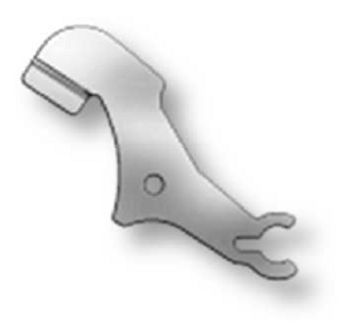










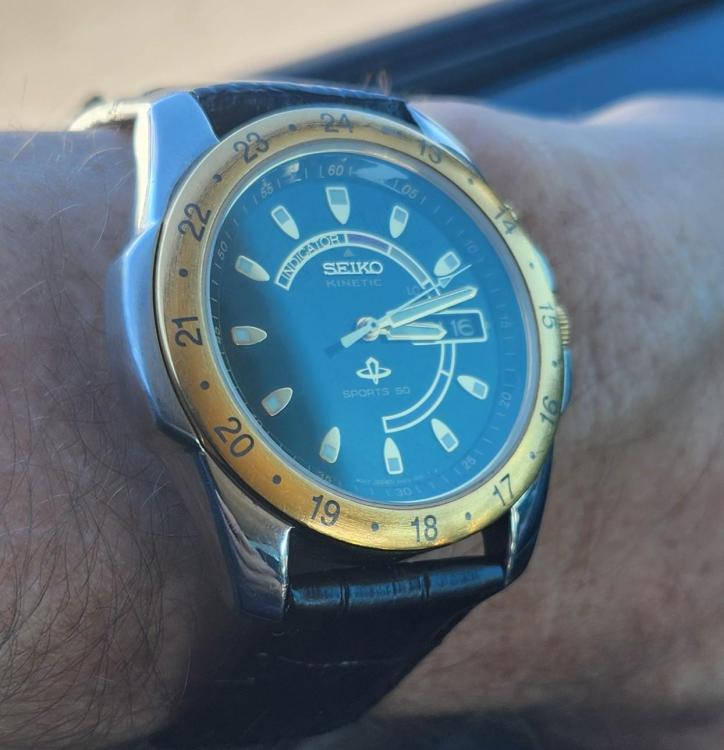





.thumb.jpg.e56d4273e2c5552bedb1964f2f003a53.jpg)
.thumb.jpg.710d886d7f8928d18ac339c827deab58.jpg)
